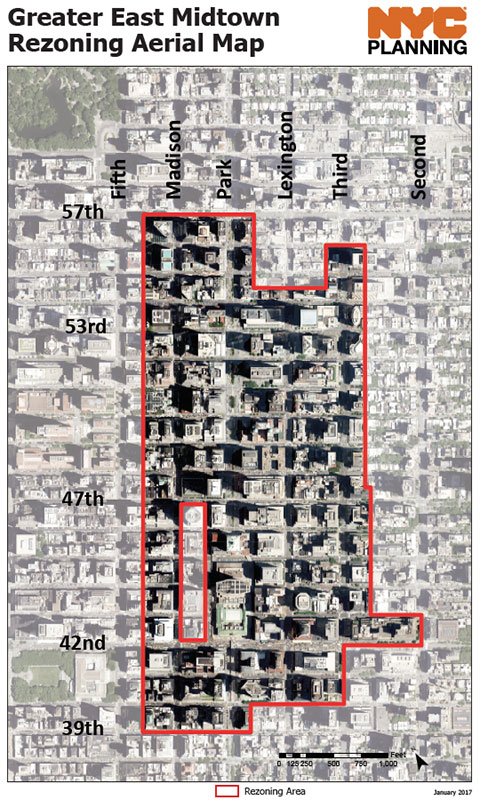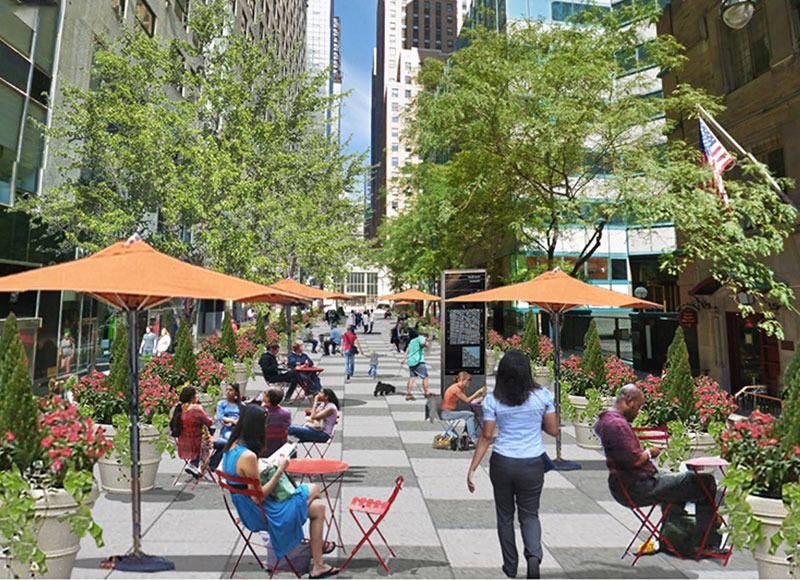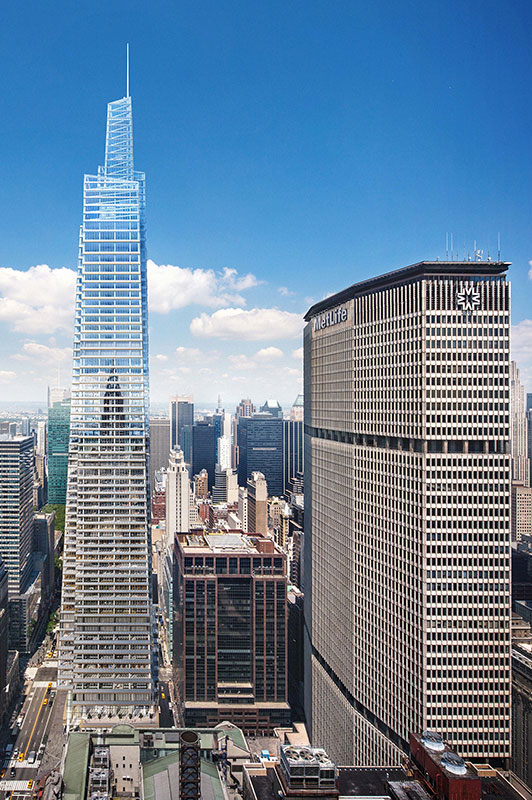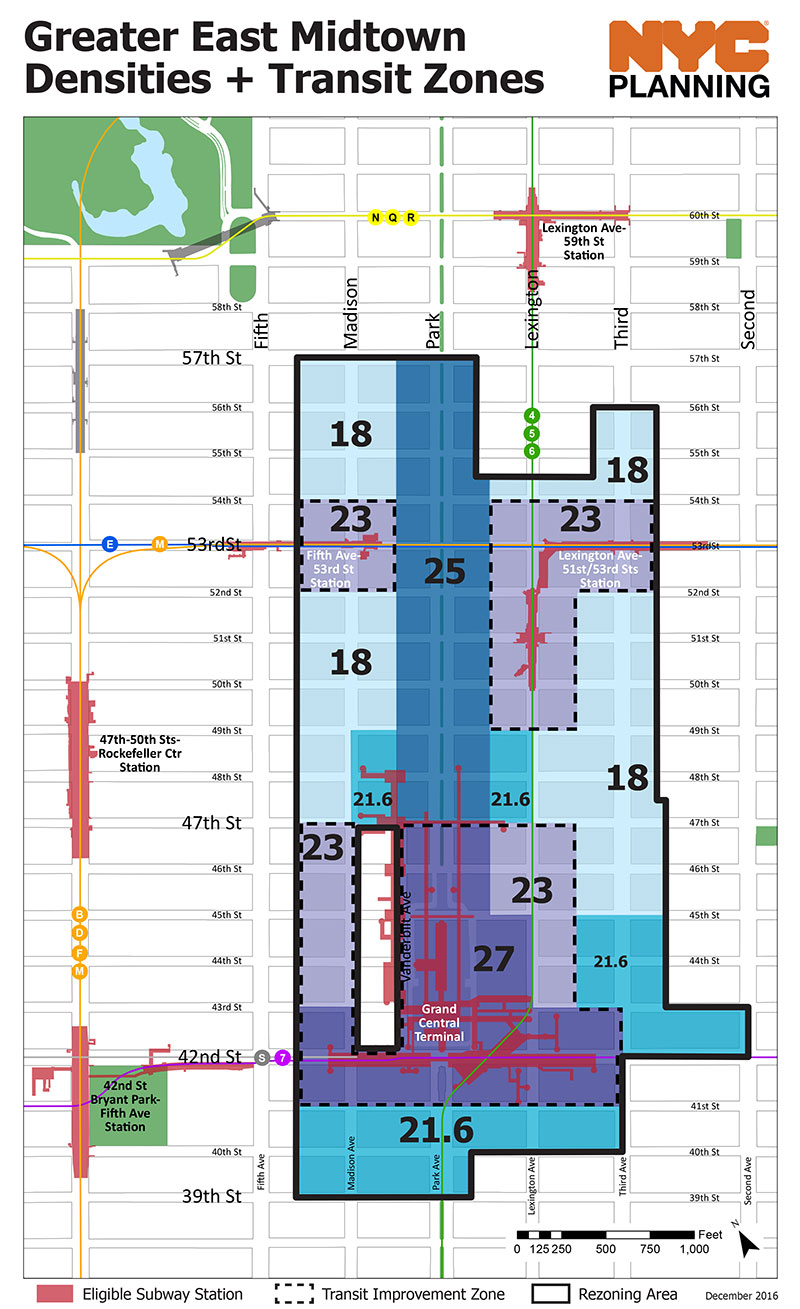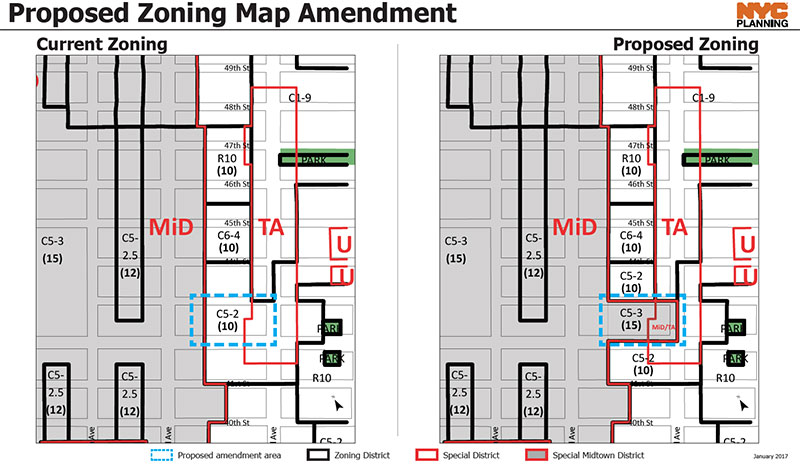
 Department of City Planning311
Department of City Planning311 Search all NYC.gov websites
Search all NYC.gov websites
Greater East Midtown
On August 9th, 2017, the City Council adopted the Greater East Midtown text amendment with modifications. The ![]() text amendment is now in effect
text amendment is now in effect
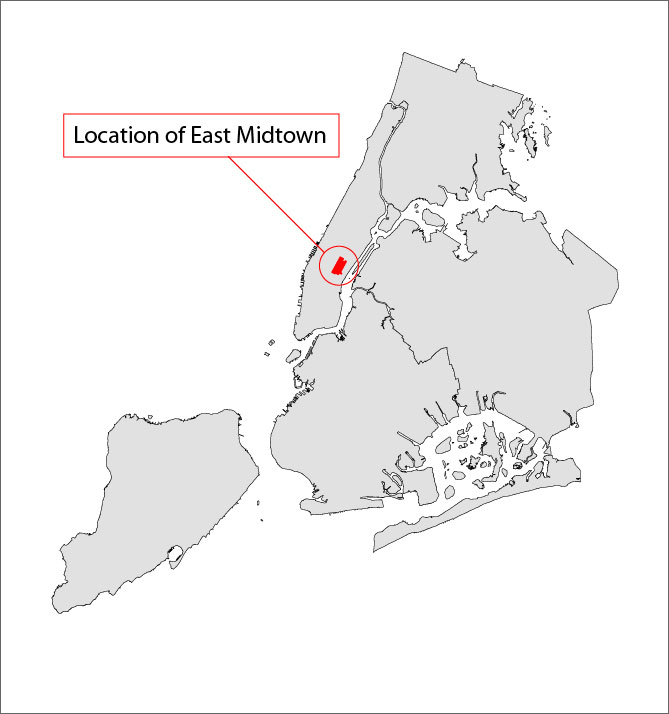
The Greater East Midtown business district is one of the largest job centers in the region and one of the highest-profile business addresses in the world. It contains more than 60 million square feet of office space, more than a quarter million jobs, and numerous Fortune 500 companies. While the Greater East Midtown area currently performs well in terms of overall office district cachet, rents, and vacancy rates, DCP has identified a number of long-term challenges that must be addressed to reinforce this area’s position. A primary challenge is the area’s office building stock. DCP is concerned it may not—in the long run—offer the kinds of spaces and amenities desired by tenants, which can only be provided through new construction. As a result, Greater East Midtown faces several challenges that may compromise its long-term competitiveness, including an aging building stock, limited recent office development (and few available office development sites), an existing zoning framework that hinders new office development, and public spaces and transit infrastructure that are stretched to capacity.
The proposal area straddles the border of Manhattan Community Districts 5 and 6, and is generally bounded by Fifth Avenue, Third Avenue, East 39th Street and East 57th Street. This area is anchored by Grand Central Terminal, one of the city’s major transportation hubs and most significant civic spaces. Around the Terminal and to the north are some of the most iconic office buildings, such as the Lever House, Seagram Building, 550 Madison (formerly AT&T then Sony Building), 601 Lexington (formerly the Citigroup Building) and the Chrysler Building, line the major avenues—Park, Madison, and Lexington Avenues—along with a mix of other landmarks, civic structures and hotels.
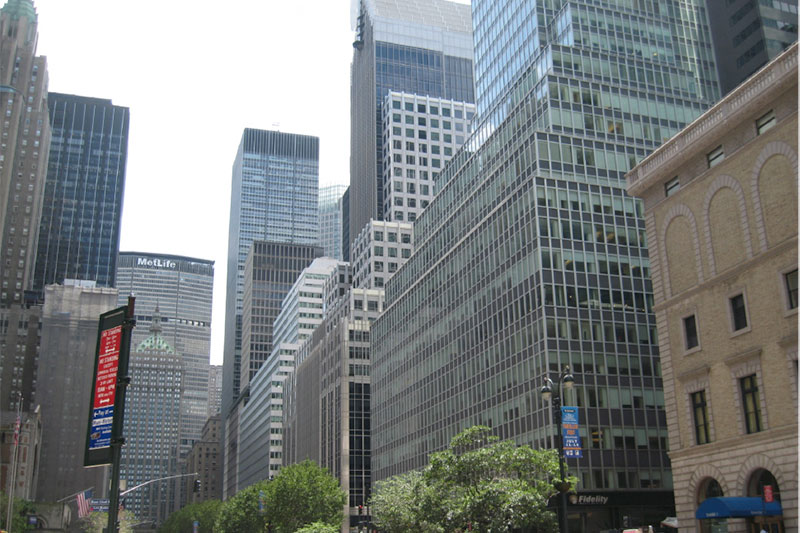
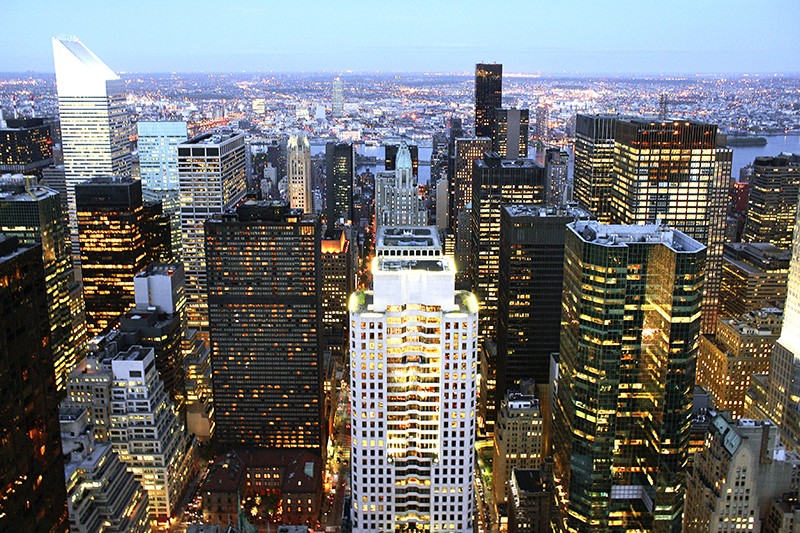
The area’s transportation network is currently under expansion through two major public infrastructure projects: East Side Access and the Second Avenue subway. East Side Access will, for the first time, permit Long Island commuters one-seat access to East Midtown through a new below-grade Long Island Railroad station at Grand Central Terminal. The Second Avenue subway will alleviate congestion on the Lexington Avenue subway line.
East Midtown’s office stock is increasingly outdated and doesn’t live up to the needs, in terms of space and amenities, of today’s potential tenants. New construction is necessary to deliver Class A office space. However, there has been limited new office development in recent decades, due in part to few viable sites and the area’s existing zoning framework. Many older buildings, constructed under pre-1961 zoning rules, have more floor area than would be permitted under the more recent rules. Incentives to redevelop are slim. Another salient challenge is the area’s above-grade pedestrian realm and below-grade transit infrastructure, which are increasingly stressed and in need of targeted improvements to make the area a more pleasant and convenient place to visit, work and live.
DCP anticipates that, without taking any proactive action, the area’s premier business district status could diminish and the large investments in transit infrastructure – including East Side Access and Second Avenue subway projects – could not live up to their full potential, in terms of bringing jobs and tax revenue for the city and region.
The City had drafted an ![]() 2013 East Midtown Proposal in 2013 to address these challenges. The 2013 Proposed Action was approved by CPC in September 2013 (
2013 East Midtown Proposal in 2013 to address these challenges. The 2013 Proposed Action was approved by CPC in September 2013 (![]() N 130247A ZRM), but was withdrawn by the City in November of that year before reaching the City Council vote, with the understanding that the project lacked City Council support for adoption. After taking office in 2014, Mayor Bill de Blasio committed the City to developing a new plan. This new plan included a stakeholder-driven process to determine a new framework for the overall East Midtown area.
N 130247A ZRM), but was withdrawn by the City in November of that year before reaching the City Council vote, with the understanding that the project lacked City Council support for adoption. After taking office in 2014, Mayor Bill de Blasio committed the City to developing a new plan. This new plan included a stakeholder-driven process to determine a new framework for the overall East Midtown area.
In 2014, DCP looked at addressing the challenges to East Midtown in a more targeted area, as a first phase of the East Midtown rezoning effort. A five-block area along the west side of Vanderbilt Avenue between East 42nd and East 47th Streets—the Vanderbilt Corridor—was the subject of a 2015 zoning text amendment (![]() N 150127 ZRM). Of note, this text amendment offered the possibility to increase floor area in exchange for substantially improving the surrounding open space. It also permitted landmarked buildings to transfer a higher amount of unused development rights to new developments nearby, as this was shown to be a primary driver of growth. The proposal was approved by the CPC in March 2015. One Vanderbilt Avenue went up under this new zoning framework -- a new 30 FAR, 1.3 million square foot commercial tower that got a special permit to increase its floor area in return for making approximately $225 million dollars’ worth of improvements to the Grand Central Terminal.
N 150127 ZRM). Of note, this text amendment offered the possibility to increase floor area in exchange for substantially improving the surrounding open space. It also permitted landmarked buildings to transfer a higher amount of unused development rights to new developments nearby, as this was shown to be a primary driver of growth. The proposal was approved by the CPC in March 2015. One Vanderbilt Avenue went up under this new zoning framework -- a new 30 FAR, 1.3 million square foot commercial tower that got a special permit to increase its floor area in return for making approximately $225 million dollars’ worth of improvements to the Grand Central Terminal.
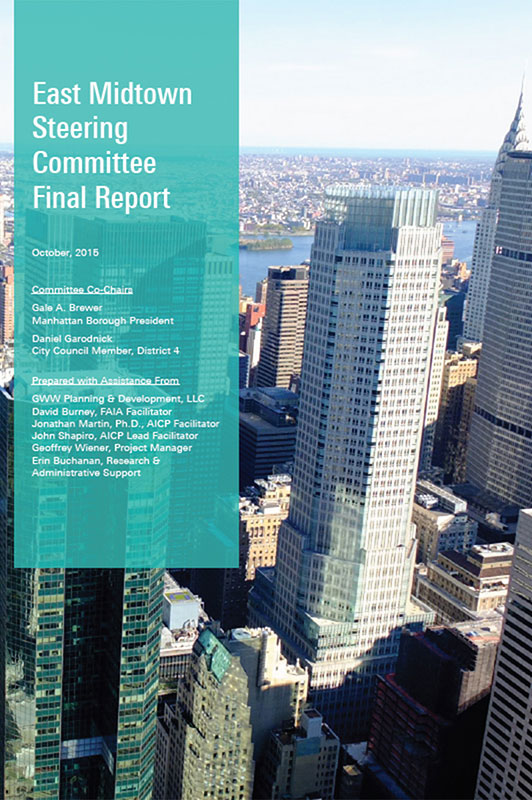
As this more targeted approach was proving to be successful, Mayor de Blasio also in 2014 established the East Midtown Steering Committee. He requested that the Manhattan Borough President and local City Council member serve as co-chairs. The Steering Committee included representatives from Community Boards 5 and 6, real estate and business representatives, and citywide civic and labor organizations. It was tasked with developing a new planning agenda for the future of East Midtown that would inform future rezoning, funding and capital commitments, and other policy decisions. The Steering Committee produced a report that included a set of recommendations. This serves as a framework for the current proposed action. A link to the report can be found ![]() here.
here.
In response to the Steering Committee’s recommendations, the Mayor’s Office formed an interagency working group tasked with creating a comprehensive proposal for Greater East Midtown. Involved agencies include DCP, the Department of Transportation (DOT), the Department of Parks and Recreation (DPR), the Landmarks Preservation Commission (LPC), the Office of Management and Budget (OMB), the NYC Economic Development Corporation (EDC), and the Metropolitan Transportation Authority (MTA). LPC has already approved the designation of 12 buildings as individual landmarks (more information can be found here) and the proposed zoning framework, described below, is in the public review process.
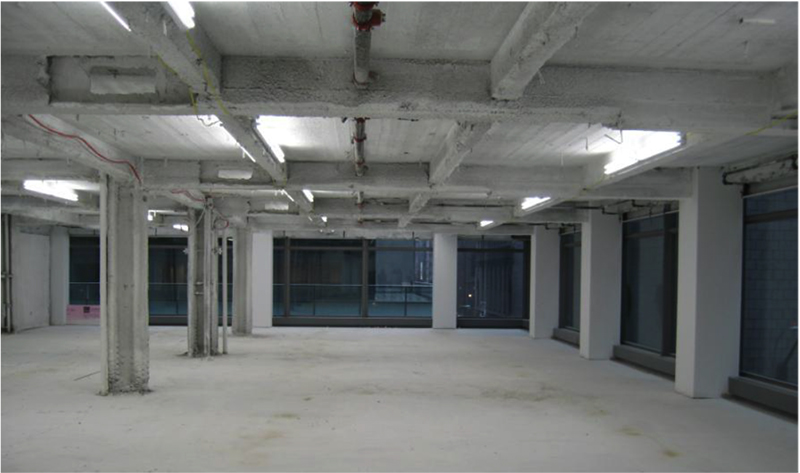
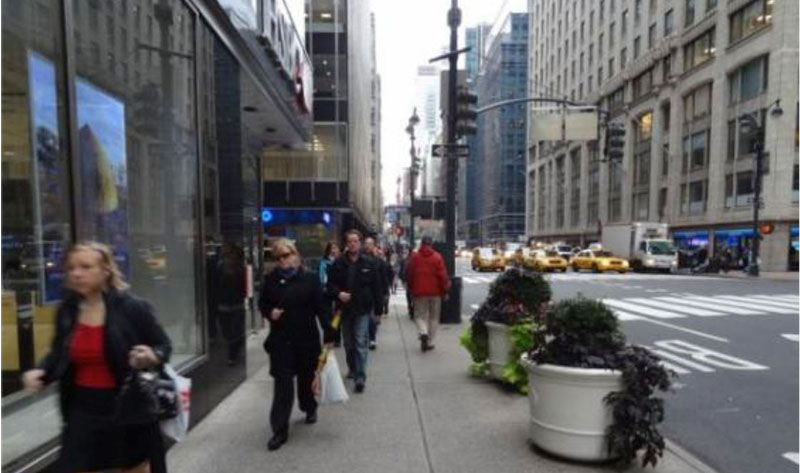
DCP’s vision is that the Greater East Midtown area will remain one of the region’s premier office districts. This will be achieved by:
- Incentivizing the development of modern, sustainable, Class-A office space;
- Reducing challenges for the redevelopment of outdated, overbuilt buildings;
- Helping to preserve landmarked buildings and maintain the area’s iconic built environment;
- Upgrading the area’s transit network and pedestrian realm, befitting its status as a world-class business address; and
- Enhancing key characteristics, such as access to light and air, active retail corridors, and the iconic street wall character in the area surrounding Grand Central Terminal.
The proposed action plans to achieve this through a primarily as-of-right development framework. In it, FAR bonuses can be earned as-of-right in exchange for pre-identified improvements to the subway infrastructure. The ability to transfer landmarked buildings’ unused development rights to any sites within the district will also be as-of-right to make it easier to preserve historic buildings.
DCP proposes two actions:
- a text amendment to establish an East Midtown Subdistrict within the Special Midtown District; and
- a zoning map amendment to rezone a portion of a block bounded by Second Avenue, Third Avenue, East 42nd Street and East 43rd Street from C5-2 to C5-3, and to include it in the Special Midtown District and new East Midtown Subdistrict.
The proposed new East Midtown Subdistrict within the Special Midtown District would supersede the existing Grand Central Subdistrict, and would allow the FARs to increase from a base maximum of 12.0 to 15.0 to between 18.0 and 27.0, depending on location.
The proposed action would focus new development on sites that are near transit stations and along wide streets. The greatest as-of-right density would be around Grand Central Terminal and along Park Avenue, with lower densities dissipating out from the Grand Central core.
Development of new high-quality office space requires appropriate sites. Consequently, sites that are eligible to take advantage of these increased FARs as-of-right must locate part of the new building along a wide street, dedicate no more than 20 percent of the building’s floor area for residential use, and comply with environmental standards. These Qualifying Sites may use three new as-of-right zoning mechanisms to achieve additional floor area:
- The completion of direct, pre-identified improvements to below-grade transit infrastructure;
- The district-wide transfer of landmark development rights (TDRs); and
- The rebuilding of legally overbuilt floor area for pre-1961 buildings.
Projects that use landmarked buildings’ TDRs will be required to make a contribution to Public Realm Improvement Fund. The contribution will equal 20 percent of the sale value, or a minimum contribution of $78.60, whichever is greater. The minimum contribution was informed by a ![]() market study of the value of development rights in midtown. The CPC will adjust the price floor every 3-5 years. The fund will be administered by a 9-member Governing Group, including 5 mayoral appointees, and representatives from the Manhattan Borough President’s Office, the Council Member for District 4, Community Board 5 and Community Board 6. The Governing Group will select street and transit projects identified by DOT and MTA as funds become available. Projects that rebuild overbuilt floor area pursuant to the third as-of-right mechanism will also be required to contribute to the Public Realm Improvement Fund.
market study of the value of development rights in midtown. The CPC will adjust the price floor every 3-5 years. The fund will be administered by a 9-member Governing Group, including 5 mayoral appointees, and representatives from the Manhattan Borough President’s Office, the Council Member for District 4, Community Board 5 and Community Board 6. The Governing Group will select street and transit projects identified by DOT and MTA as funds become available. Projects that rebuild overbuilt floor area pursuant to the third as-of-right mechanism will also be required to contribute to the Public Realm Improvement Fund.
A scoping meeting was held on September 22, 2016 that enabled the public to provide comments to inform the scope of work for the environmental review. View the Final Environmental Impact Statement.
Following certification of the original proposal, an (A) application was filed that proposes modifications to the Proposed Action. These modifications include: (1) allowing as-of-right development on midblock sites that are unable to achieve cleared frontage along a wide street due to one or more intervening landmarks; (2) allowing developments to make in-kind contributions to above-grade public realm improvements; (3) ensuring the preservation of existing easements for pedestrian access to mass transit; and (4) establishing floor area exemptions for transit easement volumes located within areas of the proposed East Midtown Subdistrict that coincide with a Special Transit Land Use District. View the ![]() original text that was certified on January 3, 2017, the
original text that was certified on January 3, 2017, the ![]() amended text filed on March 27, 2017, and the
amended text filed on March 27, 2017, and the ![]() approved text that was voted on by the City Council on August 9, 2017.
approved text that was voted on by the City Council on August 9, 2017.
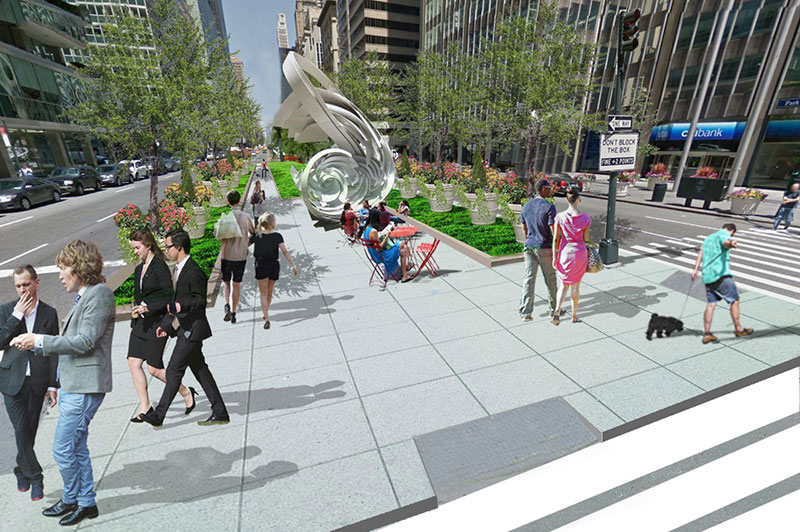
In recent years, every discussion of Greater East Midtown has focused on the urgency of improving conditions below ground for commuters (i.e, subway infrastructure), and above ground for pedestrians. DCP’s proposal facilitates upgrades to below-grade transit and, above-grade, encourages new, pedestrian-friendly public open spaces that allow people to easily access transit, their workplaces and the neighborhood’s many amenities by foot.
The MTA/NYC Transit, and the City’s Department of Transportation have been working with DCP, the East Midtown Steering Committee and local stakeholders to develop a menu of potential above- and below grade improvements. These improvements will comprise a Concept Plan that will be controlled, prioritized, and funded by a nine-member governing group through the Public Realm Improvement Fund as development occurs. The governing group would reserve the right to modify the Concept Plan, adding and removing projects based on criteria in the zoning text.
The MTA has worked closely with DCP and the Steering Committee to identify stations that predominantly serve East Midtown, and improvements at those stations that would improve congestion points and enhance capacity between the platform and mezzanine or street. The stations are:
- Lexington Ave/53rd and 51st St (E,M,6)
- Lexington Ave/59th St (N,Q,R,4,5,6)
- 5th Ave/53rd St (E,M)
- Rockefeller Center/47th-50th St (B,D,F,M)
- Bryant Park – 5th Ave (B,D,F,M,7)
- Grand Central (4,5,6,7,S)
For above-grade improvements, the concept plan will contain projects that advance the City’s vision zero program to enhance pedestrian safety and generally include:
- Pedestrian plazas, which have been successfully implemented across the city
- Shared streets” like those piloted in Lower Manhattan last summer and another of which is planned for Fordham Plaza in The Bronx; and
- Sidewalk and crosswalk enhancements at key bottlenecks on wide thoroughfares, such as bulb outs that provide more room for pedestrians to wait at intersections to cross the street and to board buses.
The proposed action also includes a zoning map amendment to rezone a portion of Block 1316, which is bounded by Second Avenue, Third Avenue, East 42nd Street and East 43rd Street. The rezoning area is currently zoned C5-2 and is outside of the Special Midtown District. The proposed action would replace the C5-2 district with a C5-3 district, and would extend the Special Midtown district to cover the area. This area would also be included in the new, proposed East Midtown Subdistrict.
On January 3rd, 2017, the Department of City Planning certified the Uniform Land Use Review Procedure (ULURP) applications (N 170186 ZRM and C 170187 ZMM) for Greater East Midtown to begin the formal review process. The proposal was referred for public review to Manhattan CB 5, CB 6 and CB 8, the Manhattan Borough Board, the Manhattan Borough President, the City Planning Commission, and the City Council.
| Milestone | Dates |
|---|---|
| Department of City Planning Certification | January 3, 2017 - |
| Manhattan Community Board 5, 6 and 8 Review |
|
| Borough Board and Borough President Review |
|
| City Planning Commission Hearing | April 26, 2017 - |
| City Planning Commission Approval with modifications* - View the CPC Reports | June 7 2017 |
| City Council Hearing | June 20, 2017 - |
| City Council Approval with modifications** | August 9, 2017 |
* CPC modifications:
On June 7, 2017, the Commission approved the proposed amended text amendment (N 170186(A) ZRM) with the following modifications:
- Governing Group | A representative from a citywide civic organization and an additional mayoral appointee were added to the Public Realm Improvement Fund Governing Group’s membership. The Governing Group’s reporting and transparency requirements were further detailed and text was added that requires the Governing Group to consider selecting an above-grade improvement before considering selection of a below-grade improvement.
- Qualifying site criteria | Allowance for a transit easement volume on a wide street to function as a development site’s cleared wide street frontage.
- Zoning lots within the East Midtown Subdistrict | Permits a zoning lot within the Special Midtown District that is at least 50 percent within the East Midtown Subdistrict to use the new zoning framework (Section 81-60), except for portions of the zoning lot within the Fifth Avenue Subdistrict.
- Height and setback controls | Clarifies that the daylight evaluation score along individual streets for a qualifying site cannot be lower than 66 percent.
- Hotel compliance | Clarifies that hotel uses existing before enactment of the Subdistrict are considered conforming uses.
** CC modifications:
On August 9, 2017, the City Council approved the proposed amended text amendment (N 170186(A) ZRM) with the following modifications:
- Qualifying site criteria | A site’s cleared frontage along a wide requirement was set at a minimum of 75 feet.
- Modified applicability of framework | Sites along the east side of Third Avenue between East 46th and East 51st streets may only use the rebuilding of overbuilt floor area mechanism.
- Mandatory Public Space | Sites of 30,000 square feet or more must provide an indoor or outdoor public space. Sites of 45,000 square feet or more must provide an outdoor public space except when precluded from doing so by district plan rules, such as street wall requirements. Ten percent of site must be dedicated to public space, or a minimum 10,000 square feet in the case of sites of 65,000 square feet or more.
- Governing group | A representative from the City Council Speaker’s Office and an additional mayoral appointee were added to the Public Realm Improvement Fund Governing Group’s membership, bringing the membership to 13, and it was clarified that the Manhattan Borough President would select the citywide civic organization appointee. The Governing Group is to be established as a local development corporation and its reporting and transparency requirements were further detailed.
- Public realm improvement fund | Draw-down requirements were established for when the fund reaches $20 million. At this threshold the Governing Group will be required to fund a project or vote to retain the funds for a future project.
- Minimum contribution | The methodology to determine the minimum contribution was modified to include only historical TDR transactions, rather than land sales which had previously been included, resulting in a minimum contribution amount of $61.49.
- Height and setback | Sites using the overbuild-rebuild provision must achieve a minimum daylight evaluation score of 66.
- Hotel vesting | A vesting provision was introduced for hotels with existing building permits.
- Urban design authorization | The new authorization permits the waiving or modification of district plan elements, for sites that provide public space, if they impair the site’s ability to provide a superior urban design relationship with the surrounding area.
- Application referral | City Planning will refer applications to the affected community board, Manhattan Borough President, and the City Council for 60 days.



